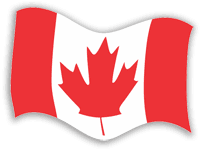 #24 First Nations: European Contact to the Present
#24 First Nations: European Contact to the Present
By Pat Brennan
| According to scientists, stone-age nomadic hunters from Siberia
crossed the Bering land bridge and migrated into the Americas
some 15-20,000 years ago. By 1000 CE, with the Inuit occupation
of the high Arctic, all of present-day Canada was at least
thinly inhabited. Apart from brief visits by Vikings some five
centuries earlier, Native-European contact began in 1534 when
French explorer Jacques Cartier entered the Gulf of St. Lawrence
in his pursuit of a route to China. At that time, most of Canada’s Aboriginal people were hunter-gatherers organized in extended family units or bands and skillfully adapted to life in a wilderness which most early French and English explorers and settlers found daunting. These small communities operated with others sharing similar social, cultural and economic traits, forming what the European newcomers called tribes. The principal settled societies were the Iroquois and Wendat (Huron) confederacies of the Great Lakes region which practised agriculture and were far more politically and militarily organized than their neighbours and the fishing-based peoples living on the Pacific coast. Initially, settlement proceeded slowly, so contact was driven mainly by the Europeans’ quest for furs, and particularly the highly prized pelt of the beaver. This trade sparked exploration, mutually-profitable economic ties, and considerable cultural exchange. Although Aboriginal peoples drawn into the fur trade ultimately lost much of their independence and were inadvertently exposed to European epidemic diseases, the trade itself depended on the maintenance of good relations between the two groups and encouraged Aboriginal people to maintain their traditional way of life. From the 1600s through the early 1800s, the British and French settlements in eastern Canada were swept up in European imperial clashes. Pre-contact Aboriginal societies were no strangers to diplomacy and conflict, and these imported wars — along with the struggle to control the fur trade — were superimposed on traditional rivalries. Maintaining their independence and way of life drove Aboriginals to war, but Europeans actively courted them as military allies. The Iroquois in particular proved dangerous adversaries of New France and later invaluable allies of the British against the Americans. However, with the passing of the last military threat to Canada in 1814 and the new emphasis on agricultural settlement, Natives’ value to the European settlers drastically declined. It did not matter that the European concept of land belonging to people was impossible to reconcile with the Aboriginal concept that the people belonged to the land — the flood of British settlers into Upper Canada (southern Ontario) required that they yield their traditional territory. As the power relationship grew increasingly unequal, treaties extinguished aboriginal title, leaving Natives with small reserves and — in keeping with the paternalist and racist atmosphere of the time — turning them into wards of the state to be civilized by the Christian churches. Henceforth, the goal of cultural assimilation would be pursued vigorously, with tragic results. By the late 1800s, settlement had moved onto the vast western prairies, repeating this process, which was in time also followed in the North. Although the North-West Rebellion (1885) was a notable exception, organized resistance was rare because First Nations leaders were willing to accommodate change they recognized was inevitable. The test of treaty arrangements would come in how Canada honoured their spirit — sadly a test the federal government would regularly fail. Despite loyal service in both World Wars, First Nations’ marginalization from broader Canadian society deepened in the first half of the 20th century. In recent decades, increasing population (after generations of decline), combined with more enlightened social values recognizing the evils of racism and Aboriginals’ growing sense of collective identity and determination to be heard, have brought positive changes. Full citizenship was finally granted in the 1960s. In 1969, an effort to create equality by effectively abolishing Indian status in the law led to First Nations political opposition to what most dismissed as a new wave of assimilation merely disguised as reform. Under the leadership of what subsequently became the Assembly of First Nations, a generally peaceful but determined campaign to re-establish lapsed rights and acquire important new ones through the courts or direct negotiations with the federal government ensued. Among these have been an ongoing series of land claims promising economic self-sufficiency, recognition of treaty and aboriginal rights in the constitution (1982), creation of the largely Inuit Nunavut Territory (1999) and some measure of redress for the cultural and other abuses of the residential school system (2007). Today, First Nations and mixed-blood people (Métis) make up nearly five percent of Canada’s population and share more fully in national life than ever before. Nevertheless, far too many still languish in poverty, poor health, and hopelessness, marginalized in isolated reserve communities and urban settings alike. The struggle for full equality remains to be won. Suggested Readings: JR Miller, Skyscrapers Hide the Heavens: A History of Indian-White Relations in Canada; Olive Dickason, Canada’s First Nations: A History of Founding Peoples from Earliest Times Next Instalment: The Settlement of Canada – New France, Upper Canada and the Prairies The Canadian Experience is a 52-week history series designed to tell the story of our country to all Canadians. Sponsored by Multimedia Nova Corporation and Diversity Media Services partners, the series features articles by our country’s foremost historians on a wide range of topics. Past articles and author bios are available at http://www.cdnexperience.ca. The Canadian Experience is copyright ©2010-2011 Multimedia Nova Corporation. |
List of published "Canadian Experience" articles |
The Canadian Experience communicates to
us about the many facets of Canada, the people, the Charter, brings us
reality and creates understanding.
Copyright ©2010 Echoworld Communications. All rights
reserved

